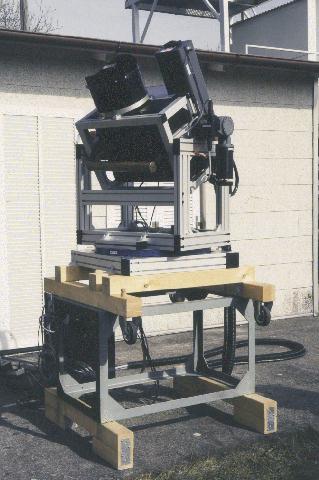The Lidar System MULIS
|
MULIS I
The lidar was built in 1993/94 by Sensorlab, Munich; it was funded in the frame of the Bavarian Climate Research Programme (BayFORKLIM). This system (MULIS I) was in operation over about one decade and participated in lidar networks (e.g. EARLINET) and several field campaigns.
Specifications MULIS I (valid approximately until 2005)
| Laser | Nd-YAG (Continuum Surelite) |
| Pulse-Energy | 175 mJ @ 1064 nm
50 mJ @ 532 nm
175 mJ @ 355 nm |
| Rep. Rate | 10 Hz |
| Pulse Duration | 6 ns |
| Beam Divergence | 0.6 mrad |
| Telescope | Cassegrainian, 30 cm diameter |
| Field of View | 1.5 – 4 mrad |
| Detectors | Pin-Diode @ 1064 nm
PMT @ 532 nm
PMT @ 355 nm |
| A/D Conversion | 12 Bit, 40 MHz |
| Range Resolution | 3.75 m |
| Overlap | 200 m – 250 m @ 4 mrad-FOV |
| Scanning | Elevation and Azimuth |
| Data Storage | variable number of shots averaged, variance, min/max |
| Size | 1.3 m * 1.3 m * 1.3 m |
| Housing | Trailer or Institute Platform |
| Power Consumption | 1.5 kW (5 kW incl. peripherals) |
|
 The lidar in its original configuration (photograph from W. Carnuth, 1995)
The lidar in its original configuration (photograph from W. Carnuth, 1995)
|
MULIS II
A major upgrade was succeeded in early 2006. Volker Freudenthaler completely redesigned the old system by adding two Raman channels (387 nm and 607 nm) and splitting the 532 nm channel into two channels to determine the state of the polarization of the backscattered radiation. All related work was performed by our group (engineering by Meinhard Seefeldner, mechanical implementation by Anton Lex) at the institute.
The specifications of the new system can be found in the EARLINET-„Handbook of Instruments“.

